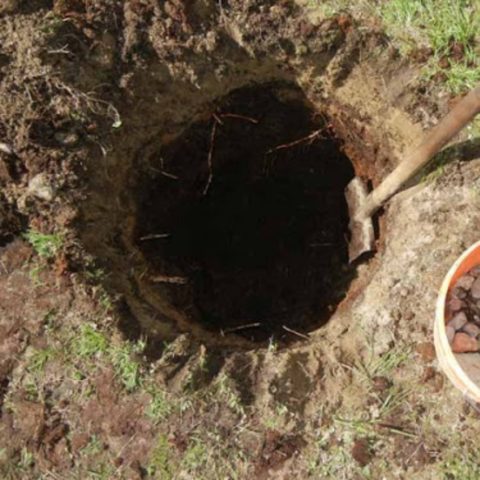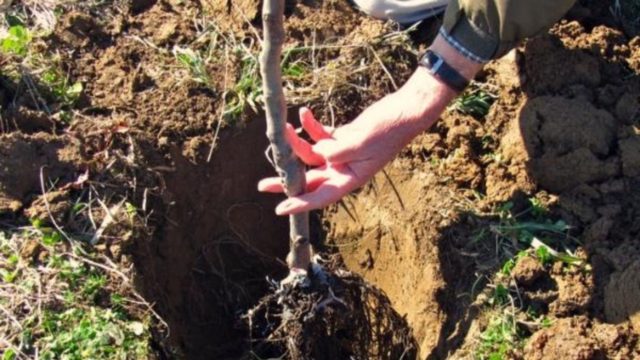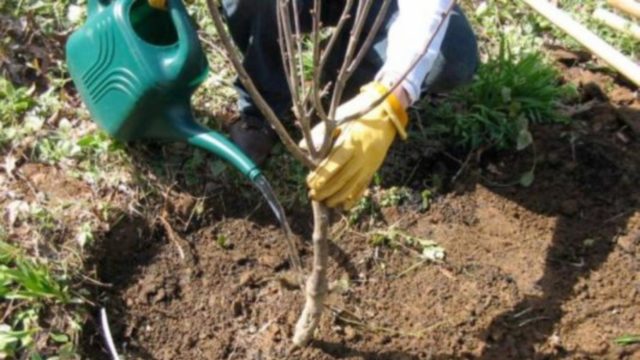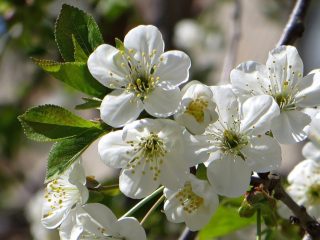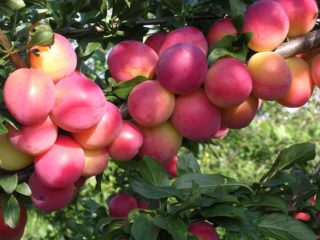Content
With the breeding of the hybrid cherry plum, the popularity of this culture has noticeably increased among gardeners. This is due to its ability to grow in any climatic conditions, quick adaptation to a new place, stable yield and high taste of fruits. One of these types is the Shater variety. Choosing from all the variety, one cannot but pay attention to it. But before making a final decision, you need to study the description of the cherry plum variety Shater in order to understand its strengths and weaknesses.
Breeding history
This species was obtained artificially at the Crimean Experimental Breeding Station. The founder of the Shater variety is Gennady Viktorovich Eremin, its leader. The basis of the species was the Sino-American plum Fibing, which was crossed with an unknown species of cherry plum. The result was so successful that it was singled out as a separate variety.
In 1991, tests were started to confirm the main characteristics of the Shater cherry plum (photo below). And after their completion, this variety was entered in the State Register in 1995. The species is recommended for cultivation in the Central, North Caucasian region.
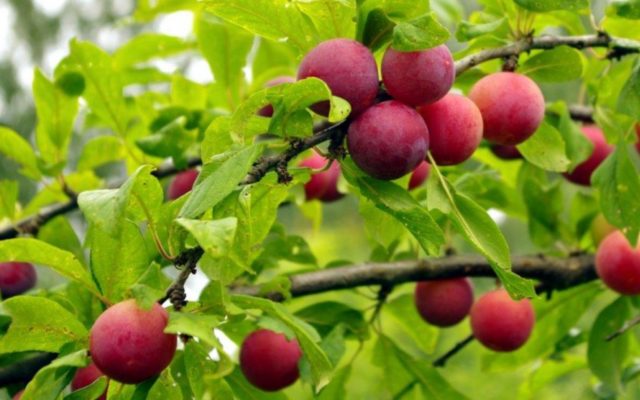
Cherry plum can grow in one place for more than 30 years
Description of the variety
This species is characterized by a low growth force, therefore the height of an adult tree does not exceed 2.5-3.0 m. The crown of the cherry plum Tent is flat, thickened with slightly drooping branches. The main trunk of the tree is even, of medium thickness. The bark is gray-brown. Cherry plum Tent forms shoots with a diameter of 2 to 7 mm. On the sunny side, they have a reddish-brown tint of medium intensity.
The leaves of the cherry plum Tent are directed upward when they bloom, and when they reach their maximum size, they take a horizontal position. The plates are up to 6 cm long, and their width is about 3.7 cm, the shape is oval-oblong. The top of the leaves is strongly pointed. The surface is wrinkled, deep green. On the upper side, the edge is absent, and on the reverse side only along the main and lateral veins. The edge of the plates is double-clawed, the degree of waviness is medium. Cherry plum leaf petioles Tent are rather long, about 11-14 cm and 1.2 mm thick.
This variety begins to bloom in mid-April. During this period, 2 simple flowers with five white petals bloom from medium-sized green buds. Their diameter does not exceed 1.4-1.5 cm. The average number of stamens in each is about 24 pieces. The anthers of the cherry plum Tent are round, yellow, slightly curved. In length, they are slightly higher than the stigma of the pistil. The calyx is bell-shaped, smooth. Pistil up to 9 mm long, slightly curved.
The stigma is rounded, the ovary is bare. The sepals of flowers are bent away from the pistil and have no edge. They are green, oval. The pedicel is thickened, short, 6 to 8 mm long.
Cherry plum fruits are large, about 4.1 cm in diameter, broadly ovate. The average weight of each is about 38 g.The main skin color is yellow-red, integumentary solid, violet. The number of subcutaneous points is average, they are yellow.
The pulp is of medium density and granularity, yellow-green hue. Cherry plum Tent has a pleasant sweetish taste with a small amount of acidity, a mild aroma. The skin of the fruit is thick and separates well from the pulp. Slightly perceptible when eaten. Inside each fruit there is a slightly rough bone, 2.1 cm long and 1.2 cm wide. It separates poorly from the pulp even when the fruit is fully ripe.
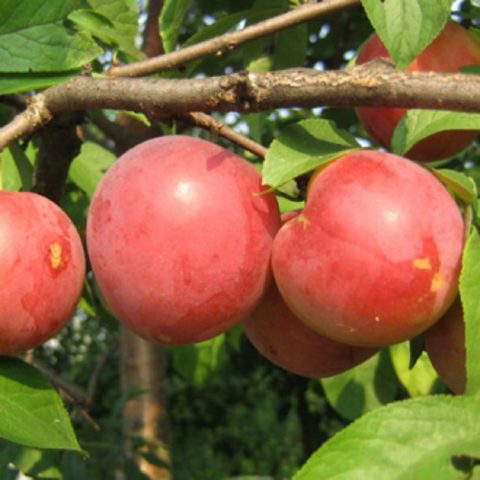
When cutting cherry plum fruits Tent, the pulp darkens slightly
Characteristics
Before opting for this variety, you must first study its characteristics. This will allow assessing the degree of productivity of the Shater cherry plum and the possibility of its cultivation on a personal plot, depending on climatic conditions.
Drought tolerance
This hybrid plum is able to tolerate a lack of moisture for a short period. In case of prolonged drought, the tree needs regular watering. This is especially true during the period of ovary and fruit ripening.
Frost resistance of plum Tent
The tree does not suffer from a drop in temperatures down to -25 degrees. Therefore, cherry plum Tent belongs to the category of frost-resistant species. And even in the case of freezing of the shoots, it quickly recovers. Therefore, its productivity does not decrease against this background.
Cherry plum pollinators Tent
This variety of hybrid plum is self-fertile. Therefore, to obtain a stable high yield, it is necessary to plant other types of cherry plum on the site with the same flowering period, which will contribute to cross-pollination.
In this capacity, you can use the following varieties:
- Pavlovskaya Yellow;
- Pchelnikovskaya;
- Comet;
- Sun;
- Lodva.
Is it possible to pollinate with Tsar's cherry plum
This variety is not suitable for pollination of the Shater hybrid plum, as it is a medium-flowering species. Tsarskaya cherry plum forms buds 10-14 days later. In addition, the frost resistance of this species is much lower, therefore, not always both varieties can be grown in the same area.
Flowering period and ripening time
Cherry plum Tent begins to form buds in mid-April. And by the end of this month, all the flowers are blooming. The duration of the period in the presence of favorable conditions is 10 days. The cherry plum Tent ripens after 3 months. The first harvest can be taken in late July or early August.
Productivity, fruiting
This variety begins to bear fruit 3-4 years after planting. The volume of harvest from 1 adult cherry plum tree Tent is about 40 kg. This is considered a good result when compared to other species.
Scope of the fruit
Cherry plum Tent is one of the universal species. Its fruits are distinguished by high taste, therefore they are ideal for fresh consumption. Also, the thick skin and medium density of the pulp make it possible to process this variety, using it for the preparation of winter blanks.
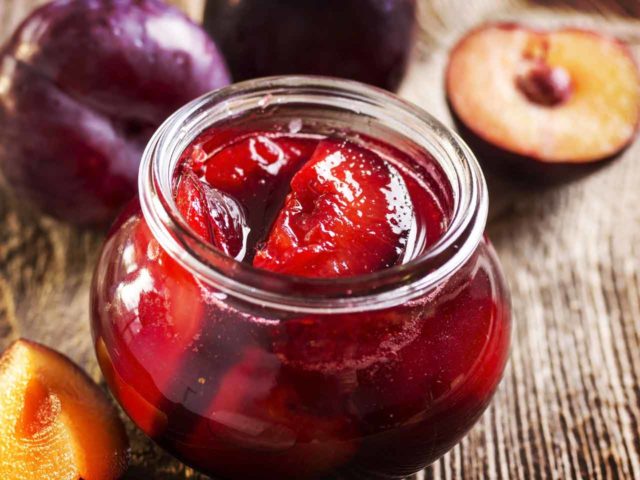
During heat treatment, the consistency of the fruit is preserved
This hybrid plum can be used to cook:
- compote;
- jam;
- jam;
- juice;
- adjika;
- ketchup.
Disease and pest resistance
This variety of hybrid plum is resistant to diseases and pests. But to maintain its natural immunity at a high level, it is recommended to carry out preventive treatment annually in the spring.
Advantages and disadvantages
Cherry plum Tent has certain strengths and weaknesses.Therefore, you need to familiarize yourself with them in order to get a complete picture of this variety and understand how critical its shortcomings are.
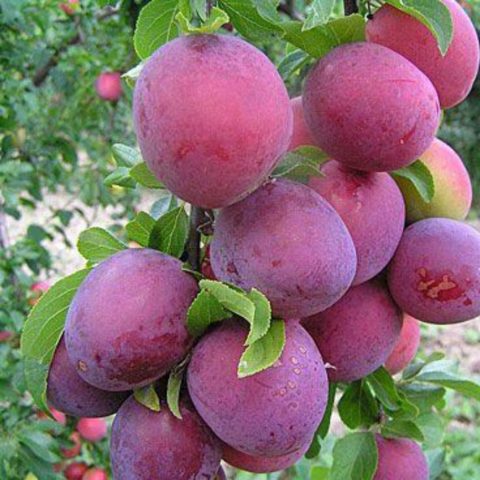
Cherry plum fruits Tent can be stored for 10 days without loss of taste
Main advantages:
- early ripening of fruits;
- high productivity;
- versatility of application;
- excellent taste;
- small height of the tree, which facilitates maintenance;
- immunity to diseases and pests;
- high frost resistance;
- excellent presentation.
The disadvantages include:
- extended period of fruiting;
- incomplete separation of the bone;
- needs pollinators.
Planting and caring for cherry plum Tent
In order for a seedling of this variety of hybrid plum to fully grow and develop, it is necessary to plant it taking into account the requirements of the culture. At the same time, it is important not only to choose the right place, but also to observe the optimal timing, and you should also take into account what crops you can grow cherry plum Tent close to.
Recommended timing
Planting a seedling of this variety should be carried out in the spring before bud break. In the southern regions, the optimal period for this is the end of March or the beginning of the next month, and in the central regions - the middle or the end of April.
Choosing the right place
For a hybrid plum, choose a sunny area protected from strong gusty winds. Therefore, it is recommended to plant cherry plum Tent from the southern or eastern side of the site.
This culture is undemanding to the composition of the soil, so it can be grown even in heavy clay soil, if peat and sand are initially added to it. The groundwater level on the site should be at least 1.5 m. Although cherry plum is a moisture-loving crop, it does not tolerate long-term stagnation of moisture in the soil, and as a result, it may die.
What crops can and cannot be planted next to cherry plum
For the full growth of the seedling, it is necessary to take into account the possible neighborhood. You cannot plant the cherry plum variety Tent next to the following trees:
- Apple tree;
- Walnut;
- cherry;
- cherries;
- pear.
The hybrid plum gets along best with other types of culture, including barberry, honeysuckle, and thorns.
Selection and preparation of planting material
For planting, you should choose one-, two-year-old seedlings obtained by cuttings or from the shoots. They are able to quickly recover in case of freezing in winter.
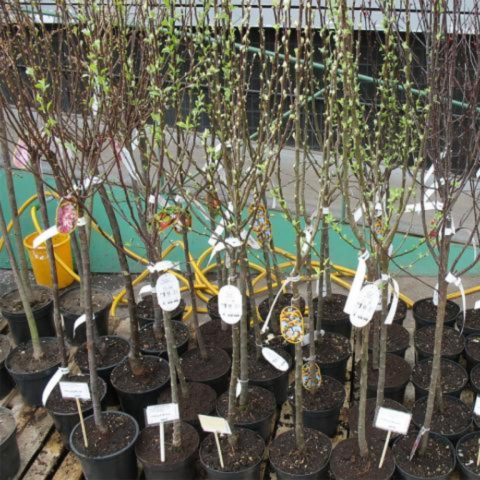
The seedling for planting should not show signs of the beginning of the growing season
When buying, you should pay attention to the bark so that there is no damage. The root system should consist of 5-6 well-developed flexible processes without fractures and dry tips.
Landing algorithm
Planting cherry plum Tent can be handled by a gardener who does not even have many years of experience. This procedure is carried out according to the standard scheme. It is important to remember, however, that at least 2 pollinators must be planted in order to obtain a good yield of the hybrid plum.
The planting pit should be prepared 2 weeks before disembarkation. Its size should be 60 by 60 cm. At the bottom, lay a layer of broken brick 10 cm thick. And fill the remaining 2/3 of the volume with a soil mixture of turf, peat, sand, humus in equal amounts. You should also add 200 g of superphosphate, 100 g of potassium sulfate and 1 tbsp. wood ash. Mix everything thoroughly with the earth, and then pour into the planting recess.
Algorithm of actions when landing:
- Make a small hill of soil in the center of the hole.
- Put a cherry plum seedling on it, spread the roots.
- Install a wooden support with a height of 1.0-1.2 m next to it.
- Water abundantly, wait for the moisture to be absorbed.
- Sprinkle the roots with earth, and fill all the voids.
- Compact the surface of the soil at the base of the seedling, stamp it with your feet.
- Tie to the support.
- Water abundantly.
The next day, lay 3 cm thick mulch at the base of the peat or humus tree. This will keep moisture in the soil and prevent the roots from drying out.
Follow-up care of the culture
Taking care of cherry plum Tent is not difficult. Watering is carried out 2-3 times a month in the absence of seasonal precipitation. During the heat period, irrigate the soil at the base of the cherry plum once every 10 days with the soil getting wet up to 30 cm.
Top dressing of the tree must be started from the age of three, since before that the plant will consume the nutrients that were introduced during planting. In early spring, organic matter should be applied, and during flowering and fruit formation, phosphorus-potassium mineral mixtures.
Cherry plum Tent does not need shaping pruning. It is recommended only to carry out a sanitary cleaning of the crown from thickening shoots, as well as from damaged and broken ones. Sometimes you need to pinch the tops of the branches, enhancing the growth of the side shoots.
Before winter cherry plum Tent is recommended to be watered abundantly at the rate of 6-10 buckets of water per 1 tree, depending on age. To insulate the root system, lay humus or peat mulch with a layer of 10-15 cm. If there are wounds on the trunk, treat them with a special solution. To do this, you will need to add 100 g of wood ash, lime and 150 g of copper sulfate to 5 liters of water.
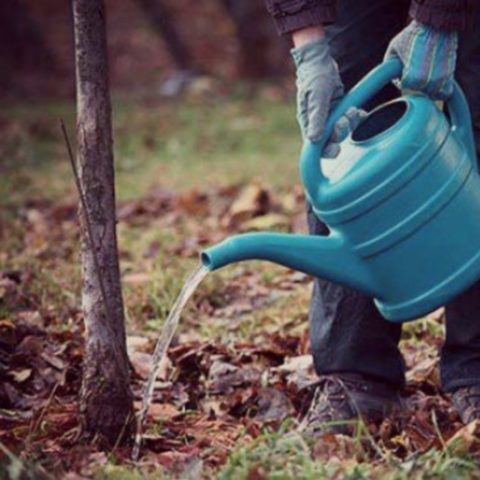
Watering cherry plum before wintering is necessary only in the absence of rain
Diseases and pests, methods of control and prevention
For prophylaxis, in early spring, cherry plum should be treated with a Bordeaux mixture or copper sulfate. You also need to whitewash the tree trunk and skeletal branches with lime. It is recommended to re-process the crown after flowering using urea in the proportion of 500 g of the product per 10 liters of water.
Conclusion
A detailed description of the cherry plum variety Shater will allow each gardener to evaluate the advantages and disadvantages of this species. The information also makes it possible to compare it with other hybrid plums and choose the most suitable option, depending on the climatic conditions of the region.
